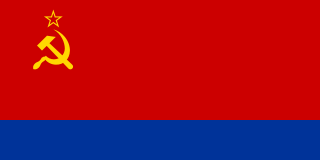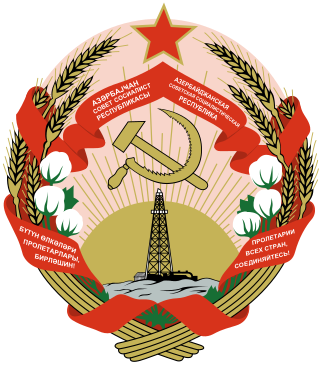
The Azerbaijan Soviet Socialist Republic, also referred to as the Azerbaijani Soviet Socialist Republic, Azerbaijan SSR, Azerbaijani SSR, AzSSR, Soviet Azerbaijan or simply Azerbaijan, was one of the constituent republics of the Soviet Union between 1922 and 1991. Created on 28 April 1920 when the Russian Soviet Federative Socialist Republic brought pro-Soviet figures to power in the region, the first two years of the Azerbaijani SSR were as an independent country until incorporation into the Transcaucasian SFSR, along with the Armenian SSR and the Georgian SSR.

Ayaz Niyazi oghlu Mutallibov was an Azerbaijani politician who served as the first president of Azerbaijan. He was the last leader of Soviet Azerbaijan, and first President of Azerbaijan from 18 May 1990 until 6 March 1992 and from 14 May until 18 May 1992.

The Azerbaijan Communist Party was the ruling political party in the Azerbaijan SSR, making it effectively a branch of the Communist Party of the Soviet Union. It was formed on 20 February 1920, when the Muslim Social Democratic Party, Communist Party of Persia, Ahrar Party and the Baku Bolsheviks joined together to establish the Communist Party of Azerbaijan. On 1 April of the same year, the Fifth Cabinet of Ministers of the Azerbaijan Democratic Republic gave its resignations and all the power to the Communist Party of Azerbaijan. The party ruled the Azerbaijan SSR until 14 September 1991 when it was formally disbanded. Nevertheless, former leaders and members of the communists continued to play a role in the family- and patronage-based political system. The Communist Party of Azerbaijan won the first multi-party elections in Azerbaijan that took place on 30 September and 14 October 1990 for the Supreme Soviet, obtaining 280 out of 360 seats.

The National Assembly, also transliterated as Milli Mejlis, is the legislative branch of government in Azerbaijan. The unicameral National Assembly has 125 deputies: previously 100 members were elected for five-year terms in single-seat constituencies and 25 were members elected by proportional representation; as of the latest election, however, all 125 deputies are returned from single-member constituencies.

The Declaration "On the Restoration of Independence of the Republic of Latvia" was adopted on 4 May 1990 by the Supreme Soviet of the Latvian SSR in which Latvia declared independence from the Soviet Union. The Declaration stated that, although Latvia had de facto lost its independence in 1940, when it was annexed by the Soviet Union, the country had de jure remained a sovereign country as the annexation had been unconstitutional and against the will of the Latvian people.

Supreme Soviet elections were held in the Ukrainian SSR on 4 March 1990, with runoffs in some seats held between 10 and 18 March. The elections were held to elect deputies to the republic's parliament, the Verkhovna Rada. Simultaneously, elections of oblast councils also took place in their respective administrative divisions.

Parliamentary elections were held in the Latvian SSR on 18 March 1990. It was the first free parliamentary election in Latvia since 1931 and saw 201 deputies elected to the Supreme Soviet of the Latvian SSR, 170 of them in the first round. Run-off elections were held on 25 March 1 and 29 April. The Popular Front of Latvia won over two-thirds of the vote. Unlike its Estonian and Lithuanian counterparts, the Latvian Communist Party did not separate from the Communist Party of the Soviet Union. Nonetheless, on 3 May 1990, the new Supreme Soviet re-elected the Communist Party member Anatolijs Gorbunovs as its chairman, effectively the leader of Latvia. He subsequently resigned from the party, and a year later the Communist Party was banned by the parliament.
Supreme Soviet elections were held in the Lithuanian SSR on 24 February with run-off elections on 4, 7, 8 and 10 March 1990 to elect the 141 members of the Supreme Soviet. In six constituencies, voter turnout was below the required minimum and a third round was held on 17 and 21 April. For the first time since 1940 elections to the People's Seimas, non-communist candidates were allowed to run. The elections were the first free nationwide elections since 1926, and only the fifth free elections in all of Lithuanian history.

The Supreme Soviet was the common name for the legislative bodies (parliaments) of the Soviet socialist republics (SSR) in the Union of Soviet Socialist Republics (USSR). These soviets were modeled after the Supreme Soviet of the USSR, established in 1938, and were nearly identical.

The Communist Party of Armenia was a branch of the Communist Party of the Soviet Union within the Armenian SSR, and as such, the sole ruling party in the Armenian SSR.

Legislative elections were held in the Soviet Union on 26 March 1989 to elect members of the Congress of People's Deputies, with run-offs on 2, 9 and 20 April and 14 and 23 May. They were the first partially free nationwide elections held in the Soviet Union, and would be the last national elections held in that country before its dissolution in 1991. The elections were followed by regional elections in 1990, which would be the last regional elections to take place in the country.

An independence referendum was held in the Armenia SSR on 21 September 1991 to determine whether to secede from the Soviet Union. It followed a declaration of independence on 23 August 1990. 99.5% of voters voted in favour, with a turnout of 95%. The country officially became an independent state on 23 September 1991.

Mir Bashir Fattah oghlu Gasimov was a Soviet and Azerbaijani revolutionary and statesman. Twice receiver of Order of Lenin and two more orders.
The Presidium of the Supreme Soviet of the Ukrainian Soviet Socialist Republic, referred to between 1991 and 1996 as the Presidium of the Verkhovna Rada of Ukraine was the permanent body of the Supreme Soviet of the Ukrainian SSR then of the Verkhovna Rada, accountable to the Supreme Soviet in its activity, and, within the nominal limits prescribed by the Constitution of the Ukrainian SSR, performed functions of the highest state power in the Ukrainian SSR. It was first established by the constitution in 1937 to replace the Central Executive Committee of Ukraine. Its membership was elected for the first time on December 27, 1938, at the first session of the Supreme Soviet of the Ukrainian SSR. The presidium later became the permanent body of the post-Soviet legislature of Ukraine, the Verkhovna Rada, but was dissolved upon the adoption of the Constitution of Ukraine on June 28, 1996.
Elections to the Supreme Soviet of the Estonian SSR were held on 16 February 1947. They were the first elections since the Estonian SSR was declared on 21 July 1940 and the first after World War II.

The Declaration and Treaty on the Formation of the Union of Soviet Socialist Republics officially created the Union of Soviet Socialist Republics (USSR), commonly known as the Soviet Union. It de jure legalised a political union of several Soviet republics that had existed since 1919 and created a new federal government whose key functions were centralised in Moscow. Its legislative branch consisted of the Congress of Soviets of the Soviet Union and the Central Executive Committee of the Soviet Union (TsIK), while the Council of People's Commissars composed the executive.

The Supreme Soviet of the Azerbaijan SSR, later renamed as the Supreme Soviet of the Azerbaijan Republic from 1991 until its abolition in 1995, was the supreme soviet of the Azerbaijan SSR, and later the Republic of Azerbaijan. In 1994, the Supreme Soviet was renamed to the National Assembly and was officially disbanded in 12 November 1995 when a semi-presidential system was implemented.

The 1921 Constitution of the Azerbaijan Socialist Soviet Republic was adopted by the Central Executive Committee of the Azerbaijan SSR at the 1st All-Azerbaijani Congress of Soviets on 19 May 1921. The constitution abolished the Azerbaijan Democratic Republic.

The 1927 Constitution of the Azerbaijan Socialist Soviet Republic was adopted by the Central Executive Committee of the Azerbaijan SSR at the 5th All-Azerbaijani Congress of Soviets on March 26, 1927.
The 1938 Ukrainian Supreme Soviet elections were held in the Ukrainian SSR on 26 June 1938 to elect deputies to the Supreme Soviet. They were held alongside elections to the Supreme Soviet of the Russian SFSR as well as regular oblast councils and followed the national elections to the Supreme Soviet of the Soviet Union on 12 December 1937.















